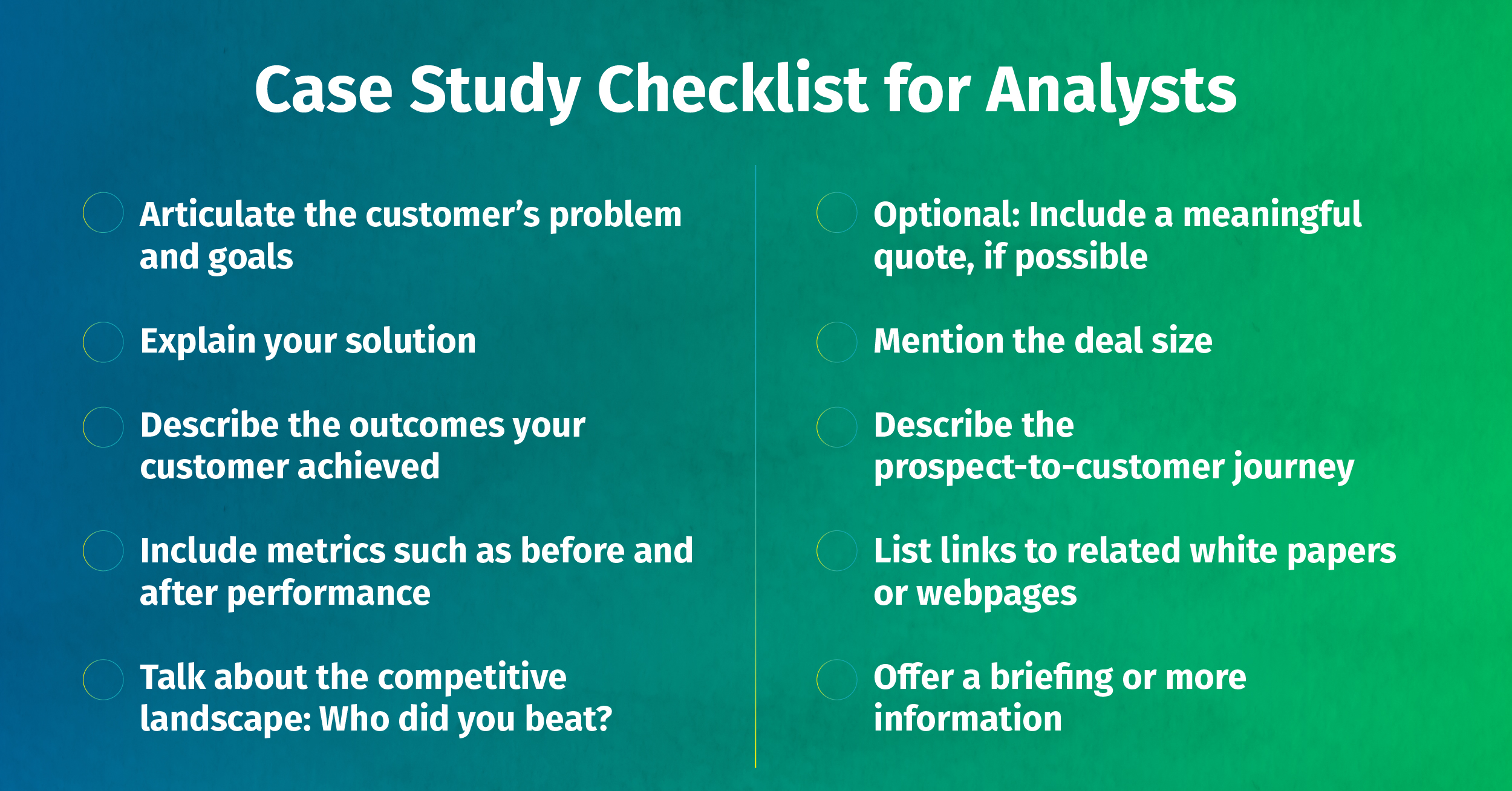Beth Torrie is a Tercera Advisor and a strategy and positioning expert with more than 20 years of experience, from startups to large enterprises. She has extensive relationships with industry analysts, and has managed more than a hundred Wave, Magic Quadrant, Marketscape, and Green Quadrant submissions.
One question I frequently get from business leaders: Just how important is analyst relations (AR) really?
Especially when it comes to technology services firms, which aren’t as dependent on evaluative analyst reports as product firms might be. Wouldn’t it be better to simply hire a new salesperson than spending the time and money to pursue industry analysts?
The fact is analysts are one of the most effective channels for reaching enterprise IT buyers. In addition to helping with prospects, analysts can also help services firms break into new markets, develop more targeted solutions, establish more effective market positioning, and improve overall differentiation. Not every firm is ready to invest in a strategic analyst relationships program, but most firms can benefit from gaining visibility and building mutually beneficial relationships with these influencers.
In this blog, I explore a few high-value, low-cost tactics that can help firms develop fruitful relationships with analysts — without breaking the bank.
What are industry analysts, and why do they matter?
Industry analysts are subject matter experts on technology and services. They advise clients and publish research and data that shape vendor selection, deployment decisions and influence investments. Analysts, and the reports they publish, are one of the most influential marketing channels for services firms. More than half of IT managers rely on them to inform purchase decisions.
Analysts, and the reports they publish, are one of the most influential marketing channels for services firms.
Gartner alone reports having customers in 90+ countries, including much of the Fortune 1000, and receives an estimated 250,000 inquiries each year from end-user clients. Investors and potential acquirers rely on analyst input to vet M&A targets, while top tier media uses them as sources for articles.
Beyond driving buying decisions, analysts and industry reports can also expand market awareness of vendors and can elevate brand positioning. They offer insights into industry and competitive trends, helping firms make better decisions and pinpoint market alignment. They provide access to market data and professional viewpoints that lead to informed decisions, which are sometimes required by purchasing. By revealing new trends and industry opportunities, analyst insights frequently help vendors stay one step ahead of rivals. And by influencing investor and customer perceptions, analyst validations and recommendations can be effective tools in sales and marketing campaigns.
When to invest in a dedicated analyst relations program
Analyst relations may be marketing manna, but only if your firm is ready. Before investing in a dedicated strategic analyst relations program, it’s important to have:
- Referenceable clients who represent your ideal customer profile (ICP).
- Confidence that you offer a truly differentiated solution and have customers who can vouch for it. Many vendors speak with analysts like Gartner early in their growth, especially when they can solve a unique challenge.
- A spokesperson (or spokespeople) who can communicate in depth and with clarity the firm’s offerings and differentiating factors.
- A willingness to devote executive time and energy into building mutually beneficial relationships.
Most analyst firms have subscription models that give vendors access to analysts and their research. These are expensive, and you need to put time and resources into using the subscription. Subscriptions don’t guarantee results, but they do ensure access and attention, which is half the battle. However, there are ways you can advance your market position without investing in a subscription or in tandem with other marketing initiatives.
Cost-effective techniques for developing analyst relationships
There are a number of ways to build valuable analyst relationships on a limited budget. One of the easiest ways is to brief analysts on big moves, such as taking on capital, launching a major new service, or announcing an acquisition. You don’t need to have a subscription to ask for a vendor briefing, although it’s not guaranteed they’ll accept and it is a one-way information sharing session. Once you have conducted an initial briefing, it’s beneficial to maintain a cadence communicating milestones, such as hitting a certain revenue target, adding a key customer number, or signing a seven-figure deal that you want everyone to know about.
Another low-cost and potentially effective option is for executives to follow and engage with analysts on social media. This works particularly well when a vendor can offer information of value to analysts. For instance, one of our clients publishes an annual state of digital accessibility report, which we promote by holding a webinar specifically for analysts, tagging them on social media, and requiring them to include a citation or hashtag if they use the material.
Other proven options, which we discuss in more detail below, include leveraging events, capitalizing on customer testimonials, and targeting strategic relationships with a small number of boutique analysts.
Taking advantage of events
Events provide valuable opportunities to interact with analysts. You can capture their attention in various ways, such as featuring your firm’s experts as conference speakers or facilitating interactions between executives, customers and analysts at the event. One-on-one meetings (without PowerPoint decks) is a productive way to engage analysts, as is inviting them to coffees, dinners or cocktail parties.
It’s vital to incorporate customers in interactions. Analysts may want to believe your story, but they need proof. Customer case studies can provide this and earn their trust. Creating “voice of the customer” analyst outreach that highlights tangible benefits you’ve delivered is one of the quickest ways to provide trustworthy evidence of your ability to execute.
It’s vital to incorporate customers in interactions. Analysts may want to believe your story, but they need proof. Customer case studies can provide this and earn their trust.
Your testimonials should emphasize features that differentiate your firm. They can be emailed to analysts who cover your category, ideally with personal notes highlighting how the stories align with each analyst’s coverage. They should always include a call to action, such as offering a briefing or more information. The following is a checklist for what your case study should accomplish:

Foster a couple strategic relationships
Naturally, branded evaluative analyst research is the Holy Grail of IT services firms. Yet, many small- to mid-sized services firms can’t meet the criteria for the most prominent reports, such as Gartner’s Magic Quadrant, Forrester’s Wave, or IDC’s MarketScape. Another option is to target less prominent, but still influential, research reports such as Gartner’s Cool Vendor and Hype Cycle representative vendors, and IDC’s Innovators.
There are also hundreds of other research and consulting businesses that are highly respected and often easier to reach than the big firms. These boutique firms will often specialize in a specfic industry or geography. For example, Coalition Greenwich, Datos, Celent, Adox specialize in financial services, while the Tambellini Group focuses only on higher education.
Fostering a small number, or even one, analyst relationship can provide a foothold for your firm and lead to greater access to other analysts within your target market. It doesn’t require huge sums of money but it does require time and effort. Here are a few steps that will help you succeed in establishing these relationships.
- Identify a few top analysts whose research aligns with your firm’s ICP
- Craft personalized content that speaks directly to the analysts’ focus areas
- Create targeted campaigns, such as connecting with them on social media, or providing proprietary research, insights, case studies, etc.
- Build relationships through briefings and event meet-ups
- Use feedback from analysts to refine your strategy and messaging, and let them know what was helpful
- Remember, the best relationships are symbiotic
But wait, there’s more…
The tactics outlined above can help you get started without breaking the bank. With some level of additional investment, you can unlock so much more with analysts.
For organizations that see value in a strategic AR program, I’d encourage you to check out AR Learning Curve (ARLC), which is an online destination we created for analyst relations and market research education. It’s an online training program for teams who want to more effectively collaborate with industry analysts and to maximize every interaction for sales, valuation, and market positioning. It covers topics such as: how to differentiate from competitors, how to elevate product and market recommendations, how to prepare teams and executives for analyst exchanges, how to build effective relationships, and how to ensure that analysts accurately include your organization on short and long lists.
Have a specific question? You can reach me on LinkedIn or contact us at info@analystrelationslearningcurve.com.

